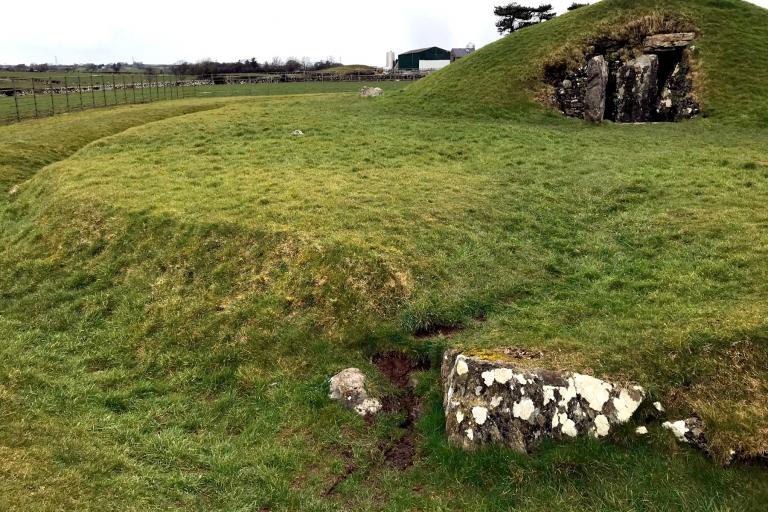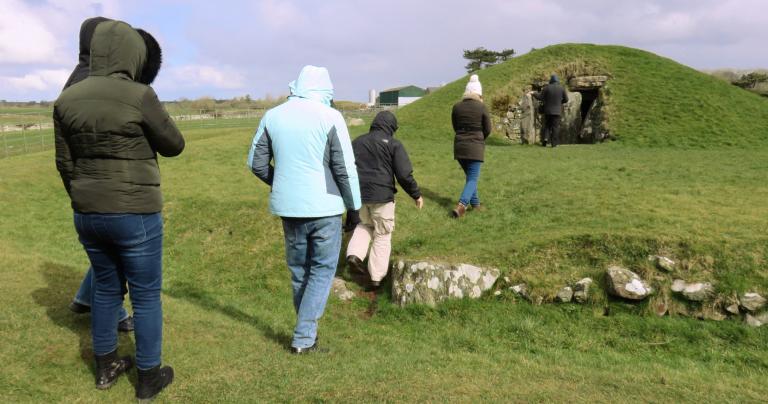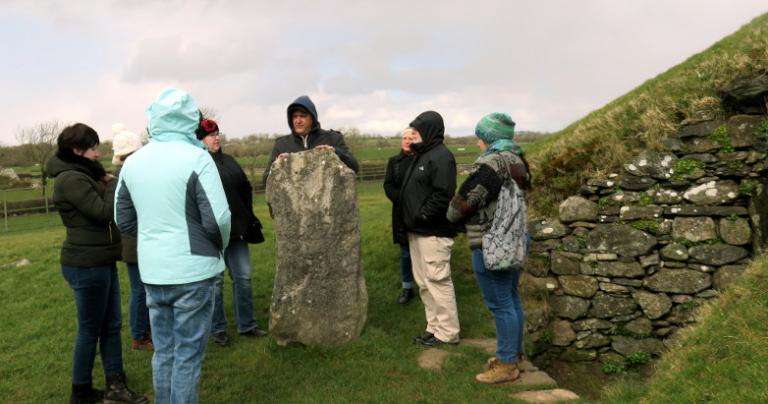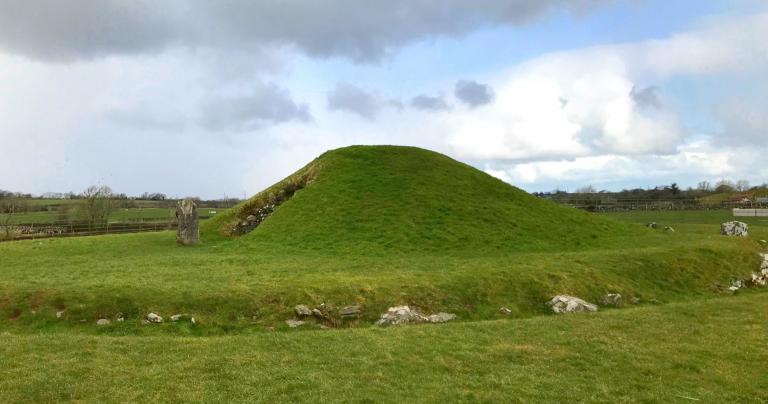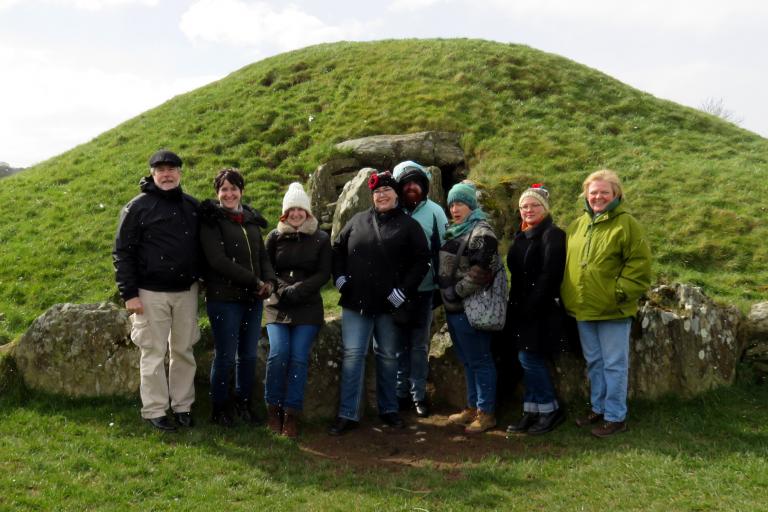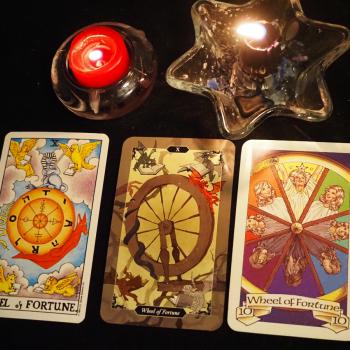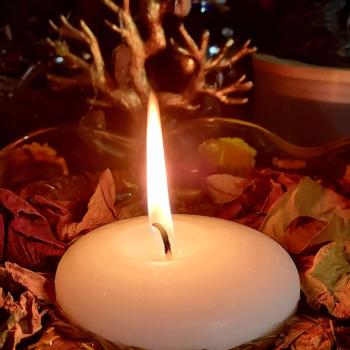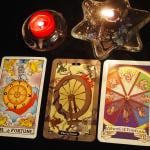Take a good look at the picture below. The bare ground on the slope of the ditch catches your eye – follow it up and to the right. See how it bends toward the stones that frame the opening in the mound. See not just wear on the grass, but indentations in the ground. A path has been worn into the ground – a new path, the result of 27 years of modern Druid processions.
Is this a bad thing? If your initial response was disapproval or even shock, you may want to give the question some deeper thought.
Bryn Celli Ddu
This is the ancient site of Bryn Celli Ddu on Anglesey in Wales. The site was first used 6000 years ago. About 5000 years ago, a henge (ditch and bank) was constructed and standing stones were erected. The ditch is still there, though the bank is gone. A thousand years later most of the standing stones were removed and a passage tomb was constructed. And then it was closed and forgotten for millennia.
Modern exploration began in the early 19th century, with the first formal excavation in 1928. Some reconstruction was done, including installing concrete roof pillars to insure the safety of those who go inside.
Archaeological exploration continues on the site, with members of the Anglesey Druid Order – who frequently hold public high day celebrations at Bryn Celli Ddu – assisting professional archaeologists on the digs.
This was my second visit to Bryn Celli Ddu. The first was the highlight of my 2014 trip to England, Wales, and Ireland. You can never re-create the specialness of your first experience of a sacred site, but it’s still a powerful place, and being there again – especially with four friends who had never been there before – was a wonderful experience.
The animism of places
Animism is the philosophical concept that things are not things but persons. This is easy to see with other animals – many of us intuitively treat our cats and dogs like persons. It’s harder to see with plants, though some of us are able to form relationships with trees and flowers. And it’s harder still with natural features like mountains and rivers, much less a human-built place like Bryn Celli Ddu.
But many of us have feelings for and relationships with cities, houses, and even cars. If we can relate to them as persons, surely we can relate to ancient sites of power and beauty as persons too.
Bryn Celli Ddu is alive. Kristoffer Hughes, head of the Anglesey Druid Order and our gracious host for our weekend on Ynys Môn, says “she loves all the attention.” After we entered the henge, Kris asked us to put our hands on one of the stones and say something we noticed about the place. After we all took a turn, he said “now say hello!” And so we did. I felt welcomed, once again.
I didn’t have the same experience at every site. Other places are alive too, and some of them are none too happy to have humans bothering them.
But Bryn Celli Ddu wants visitors. She wants Pagans coming on pilgrimages. She wants Druids celebrating the Summer Solstice with her (when the sun rises at 4:49 AM). She wants archaeologists uncovering the secrets of the ancient people who lived, worked, and worshipped there.
And none of that can be done if we treat her like a museum piece to be kept behind glass and never disturbed.
She changes everything she touches
Remember the Starhawk chant “she changes everything she touches, and everything she touches changes”? “She” can be anyone. When we interact with another person (human or otherwise) we are changed – and so are they. The changes can be small or large, positive or negative or hard to tell. But we are not the same person we were before the interaction.
All species – all persons – modify their environments. Beavers build dams on rivers. Kudzu does a wonderful job of stopping soil erosion… and also chokes out most native plants, as the Southern United States learned the hard way in the 20th century. The story of removing wolves from Yellowstone National Park and then reintroducing them is an excellent case study on the interaction of different species in an environment.
All persons modify their environments. Only humans have bulldozers, explosives, and concrete – with great power comes great responsibility. But we can’t not change our environment, which includes the places we visit.
Which modifications are ethical and proper and which are not?
Purposes, themes, and multiple incarnations
While it is easy to sense the welcoming spirit of some places and the unwelcoming spirit of others, it is impossible to say with certainty what places want for themselves. That leads skeptics to say “then land should be property to be used as its human owners see fit.” But it is not hard to understand that like all living beings, places want to continue living and want to exercise their sovereignty and autonomy to live in the ways they want to live.
If modern Druids are wearing a new path into the land, that’s in keeping with the purposes and themes Bryn Celli Ddu has had since it was first constructed. If someone wants to level the mound and build a McDonalds in its place, that’s something very different.
Actual questions are rarely so black and white. When Professor Michael O’Kelly rebuilt Newgrange in the 1960s and 70s, he was certain that the white quartz stones found around the mound were used to cover the exterior. But in order to hold them in place, he had to use modern concrete and steel. Professor George Eogan thought they formed a walkway, so when he curated Knowth for visitors, that’s how he rebuilt it.
Who’s right? More importantly, what do we mean by “right”? It’s easy to say “like it was originally” but which time? If we were to restore Bryn Celli Ddu to its “original” state, would we enlarge the mound? Replace the standing stones? Rebuild the bank? Take the mound out completely? All of a sudden the question of wearing a path into the ground doesn’t seem very important.
Loving places to death
Bryn Celli Ddu doesn’t get anywhere close to the traffic that more popular sites get. The impact of visitors is small and slow. In other places, visitors are “loving places to death.” To combat this, Newgrange allows access only on timed tickets, to restrict the impact of visitors. Stonehenge does not allow ordinary visitors to enter the stone circle except on “free days” like the Summer Solstice. At both sites, parking and reception are at an off-site visitors center, then guests are transported to and from the monument on busses.
You cannot see the Paleolithic cave art of Lascaux and Chauvet yourself. The fantastic cave paintings were preserved for tens of thousands of years only because the caves were sealed, protecting them not just from human activity, but also from environmental changes. When humans enter the caves, our mere presence raises humidity and carbon dioxide levels, promoting the growth of lichens and crystals and damaging the artwork. A replica of Lascaux was built to allow people to see the artwork in a context very close to the originals, without endangering them further.
If 30,000 year old art is destroyed, it cannot be restored. I tend to think of it as a very fragile living being that is not well suited for change. If a species goes extinct, that is a sad but natural occurrence. If we drive a species to extinction, that’s an act of criminal negligence.
What is good and proper at one place with one level of activity is dangerous and unethical at another place with a different level of activity.
Respectful, reciprocal relationships
What is true for Bryn Celli Ddu is true for your back yard as well. Places aren’t things, they’re persons – persons we can form relationships with. We will change the land – we’re animals, that’s what animals do. But if we are mindful, we won’t just use the land. We will listen to the land, and we will respect its needs and desires as much as we respect our own.
I am honored to have visited Bryn Celli Ddu on two occasions. It is a joy to walk where my ancestors (of spirit if not of blood) walked thousands of years ago. And it is equally a joy to see Bryn Celli Ddu as a living being interacting with visitors from across the island and across the world.
May she always be alive and well and changing, and never turned into a lifeless artifact of an “original” past that never was.


